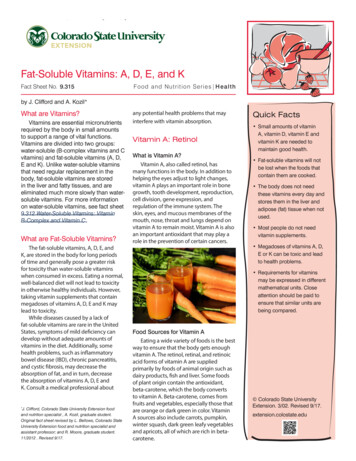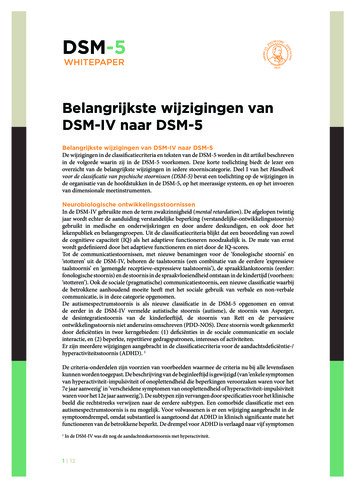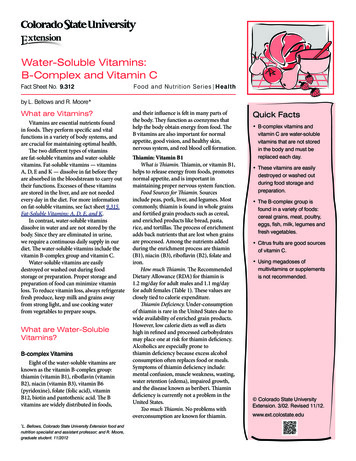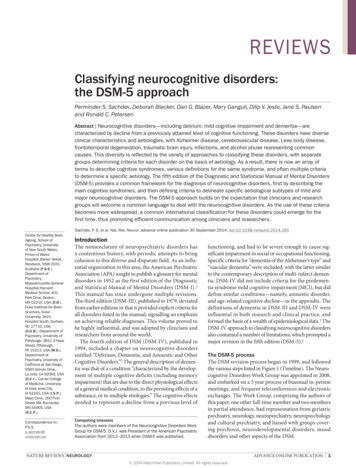
Transcription
VitaminsbasicsEverything you need toknow about vitamins forhealth and wellbeing1
IntroducingDSM’s ScientificServicesScience-based expertise supportinginnovations that meet consumer needsDSM’s Scientific Services provide expertsupport around life sciences, in particularnutrition sciences, tailored to innovations andtarget consumers. We elaborate the scientificsubstantiation to meet the requirements ofdifferent stakeholder groups, includingacademia, the scientific community, regulatoryexperts, health care professionals andconsumers. Our science-led advice enablesour customers to create and marketnutritional solutions based on healthbenefit acumen.This document explores thesignificance of vitaminsin supporting our health andwellbeing and offers anin-depth guide to thefunctions that all 13 individualvitamins have in the body.23
Why are vitaminsimportant?Vitamins are essential nutrients that are required by humans in small amounts. This is why theyare known as micronutrients. Vitamins are vital for life, aiding normal growth and healthy bodilyfunctions such as cardiovascular, cognitive and eye health.NutrientsSubstances found in food that are criticalto human growth and functionMacronutrientsMicronutrientsThey are needed for processes that create or use energy, such as the metabolism of proteins andfats, the digestion of food and absorption of nutrients, growth and development, physicalperformance, and regulation of cell function, with each vitamin having important and specificfunctions within the body. Aside from vitamin D3, vitamins are not produced by the human bodyand must therefore be obtained via the e do vitamins fit into our diets?Being complex organisms, humans have a host of nutritionalneeds. In order to maintain healthy lives, it is vital that weconsume the correct nutrients through our diet to maintainnormal body function. The different types of nutrients thatwe need can be split into two categories: macronutrients(carbohydrates, proteins and fats) and micronutrients(vitamins and minerals) (figure 1). While micronutrients, suchas vitamins, are not required in the same quantities asmacronutrients, they are equally as important for our bodies,as both work together to maintain overall health.Vitamins can be further categorized into fat-soluble andwater-soluble types. Fat-soluble vitamins, including vitaminsA, D, E and K, are stored in the body’s fat tissue which acts asa resource of fat-soluble vitamins if they are not consumedevery day. The remaining nine vitamins are water-soluble andmust be used by the body immediately once consumed.The exception is vitamin B12, which can be stored in the liverfor many B5B6!Failing to achieve sufficientvitamin intake from our dietcan cause insufficiency oreven deficiency states,which may lead to long-termhealth implications.B7B9B12CFigure 1. Categorization of vitamins45
Successfullybridgingnutritional gapsApproximately one-third of the globalpopulation has a suboptimal micronutrientstatus as a result of an insufficient intake ofvitamins and minerals, often referred to as‘hidden hunger’. A deficiency of one or morevitamins may result in a deficiency disease,such as scurvy, beriberi, rickets, osteomalaciaand others, depending on which vitamin isinsufficient in the body. Where there isinadequate intake of vitamins compared torecommendations, individuals can experienceserious, long-term health implications andincreased susceptibility to disease. As chronicdisease levels rise globally, health andwellbeing remain significant concerns forgovernments and healthcare systemsworldwide. In developed countries, risinghealthcare costs and the burden of caring foraging populations provide additionalchallenges. As such, there is a greater needfor the development of effective, nutritionalsolutions that address individual healthconcerns and lifestyle needs.Vitamins play a role in several market segments,including early life nutrition, food and beverage,dietary supplements, public health, andmedical nutrition, as well as the pharmaceuticalindustry, where vitamins are used as activepharmaceutical ingredients (APIs).Early life nutritionEmerging science shows that good nutrition during pregnancyand infancy can ‘program’ the immediate and long-term healthof a growing baby. It is therefore important that women andbabies receive the necessary nutrients at appropriate levelsduring the first 1,000 days – the period between the onset ofa woman’s pregnancy and her child’s second birthday – toprovide the foundation for a healthy childhood, adolescenceand adulthood.Food and beveragePeople often find it difficult to incorporate nutrient dense foodinto their diet i.e. food that provides a high proportion of keynutrients relative to its energy content. In these instances,fortified food and beverages can offer a convenient and costeffective solution to help prevent nutrient shortfalls andassociated inadequacies and promote long-term optimal health.Dietary supplementsTo achieve adequate and optimal nutrient status in the bodyand support good health throughout life, there is a need toaddress the nutritional balance within the diet. Dietarysupplements can complement normal food and offerconsumers a convenient and effective solution to ensureoptimal intake and status of specific vitamins, preventingnutrient shortfalls and the associated inadequacies oreven deficiencies.Public healthAs the world’s population increases and ‘hidden hunger’(i.e. malnutrition caused by chronic inadequate intake ofessential vitamins and minerals, despite sufficient intake ofcalories) affects more people worldwide, optimized nutritionis becoming ever more critical. As well as fortification offoods, multiple micronutrient supplements, micronutrientpowders and lipid-based nutrient supplements have beenproven to be effective at helping vulnerable populationgroups achieve optimum nutrition.Medical nutritionVitamins used in specialized medical nutrition solutions forthe management of a health condition or disease are critical torecovery, both for patients and for elderly populations that arenot able to meet adequate nutrient requirements via normalfood. Specialized medical nutrition products that addressdisease and age-related malnutrition include solutions fororal nutritional supplements (ONS), enteral nutrition andparenteral nutrition.Pharmaceutical applicationsTherapeutic uses of vitamins cover a wide range of medicalconditions. Emerging research suggests that vitamins, alone orin combination with other drugs, may provide a new and lowrisk treatment strategy for certain diseases. Because they areessential nutrients, vitamins are inherently biocompatible andtypically have an established safety profile.67
Contents8Forewards10The complete history of vitamins12Malnutrition – a global challenge16Continued vitamin innovation18Guide to all 13 vitamins20Vitamin A21β-Carotene26Vitamin D32Vitamin E38Vitamin K44Vitamin C50Vitamin B1 (Thiamine)56Vitamin B2 (Riboflavin)62Vitamin B3 (Niacin)68Vitamin B5 (Pantothenic acid)74Vitamin B6 (Pyridoxin)80Vitamin B7 (Biotin)86Vitamin B9 (Folic acid)92Vitamin B12 9
ForewordHidden hunger has becomea significant problemin both developing anddeveloped countriesPeter van DaelSenior Vice President,Nutrition Science & AdvocacyThe global population is growing rapidly year-on-year andpeople are living longer than ever before. While this is anexcellent example of how far we have come in terms ofscientific and medical advances, with this aging populationcomes an increased responsibility for the food, beverage anddietary supplements industries, as well as governments andhealth authorities, to support health and wellbeing throughoutlife. Hidden hunger has become a significant problem in bothdeveloping and developed countries, affecting approximatelytwo billion people worldwide. Although progress has beenmade in tackling the problem, hidden hunger still remains animportant challenge to overcome.As a purpose-led, global science-based company in Nutrition,Health and Sustainable Living, DSM will continue to transformas the world does – just as we have throughout history – usingour bright science to keep the growing population healthy. Wehave the ambition to make the world a better place, and weare thinking about tomorrow, today. Our science is alreadymaking a big impact, but only together can we create ahealthier, more sustainable future. For more than 11 years, wehave partnered with the World Food Programme (WFP) to helpdeliver nutritious food to more than 31 million beneficiariesaround the world. Additionally, DSM Scientific Services, atrusted leader in connecting people to science-led knowledgeon human nutrition and health, helps to educate people onhidden hunger and chronic malnutrition, as we strive to endhunger in all its forms.10I am a strong believer that the key to improving consumerhealth and nutrition, and combating hidden hunger, isscientific research and continuous innovation. While we havealready achieved a significant amount in the last 100 yearsof vitamin research, malnutrition persists and there are stillknowledge gaps among the scientific community. As such,current and future research must focus on addressingthe biggest issues in nutrition, which include improving andadjusting the recommendations for micronutrient consumptionworldwide to today’s lifestyles.As pioneers in vitamin research and experts in nutritionalscience, we play a pivotal role in providing science-basedinformation and in educating the population about theimportance of sustainable nutrition. Sharing best practicesand scientific knowledge, as well as having a clearunderstanding of different cultural dietary preferences, areall critical to innovate and are actions that we stronglyencourage the entire food industry to take. With new insightsand continued research, we can then find innovative andincreasingly personalized ways to keep the growing and agingpopulation healthy.Current and future researchmust focus on addressing thebiggest issues in nutrition11
The completehistory of vitaminsThe discovery that micronutrients, such asvitamins, are an essential part of the diet wasa major scientific breakthrough in ourunderstanding of health and disease. In fact,until the role of vitamins was realized foodwas simply viewed as a source of protein andenergy, and diseases such as scurvy andrickets were not linked to malnutrition. Nowthe focus has shifted completely and it is wellknown that our health depends on sufficientintake of essential vitamins and minerals, withscience indicating that adequate levels caneven reduce the risk of developing disease.The discovery of vitaminsWhile several physicians, researchers and experts hadpreviously linked healthy eating to healthy bodies, vitaminswere not actually discovered until 1912, when Polish scientist,Dr. Casimir Funk, isolated thiamine, or vitamin B1, in rice bran.Funk realized that thiamine could cure patients of beriberi, adisease now known to be caused by deficiency of the nutrient.At the time, he named the special nutritional components offood ‘vitamines’, after ‘vita’ meaning vitally important, or life,and ‘amine’, an organic derivative of ammonia, however, theylater came to be known as vitamins.Since the discovery of thiamine, there have been significantadvances in vitamin research. In 1916, American biochemistElmer V McCollum introduced the letters A, B, C and D, that weare so familiar with today, to identify each vitamin. Throughoutthe 20th century, most notably in the 1920s, there were manyscientific breakthroughs in the world of vitamins, asresearchers continued to isolate and identify various vitaminsfound in food. During this decade, vitamin C was discovered asthe antiscorbutic factor in food, vitamin D was identified byirradiating food to treat rickets, vitamin E in vegetable oils, andvitamin K in cholesterol-rich diets. By 1941 all 13 vitamins hadbeen determined and characterized (figure 2).Winning science: 12Nobel prizes have beenawarded over the years foroutstanding advances invitamin science.VitaminAlternative nameDiscoveryIsolationStructureSynthesisVitamin ARetinol1910193119311947β-CaroteneProvitamin A1831183119311950Vitamin DCalciferol1919193219361959Vitamin ETocopherol1922193619381938Vitamin KPhylloquinone1929193919391939Vitamin CAscorbic acid1912192819331933Vitamin B1Thiamine1897191219361936Vitamin B2Riboflavin1920193319351935Vitamin B3Niacin1936193619371994Vitamin B5Pantothenic acid1931193819401940Vitamin B6Pyridoxine1934193819381939Vitamin B7Biotin1931193519421943Vitamin B9Folic acid1941194119461946Vitamin B12Cobalamins1926194819561972Figure 2. The history of vitamins1213
Paving the way for major advancesin nutrition scienceEventually, this period of discovery would pave the way formajor advancements in nutrition science and lead to thedevelopment of the nutritionally rich foods and supplementsthat are so commonplace today (figure 3). In order for peopleto benefit from vitamins without relying on dietary intakealone, breakthroughs in vitamin production, formulation andapplication were required. Pharmaceutical companies, namelyin Europe and the US, were inspired to develop syntheticroutes and formulation technology applications following thenew vitamin research that was emerging. In 1934, pharmaceuticalgiant, Hoffmann-La Roche, became the first company toproduce vitamins on an industrial scale. In the years thatfollowed, all vitamins were to become available via chemicalsynthesis, fermentation or extraction from natural sources,offering opportunities to fortify diets or use as supplements.VitaminMain functionsRisks in state of deficiencyAVisual pigments in the retina; cell differentiationNight blindness, xerophthalmia;keratinization of skinβ-CaroteneAntioxidantNo known adverse side effects of a lowcarotenoid diet, provided vitamin A intakeis adequateDMaintenance of calcium balance; enhancesintestinal absorption of Ca2 and mobilizesbone mineralRickets (poor mineralization of bone);osteomalacia (demineralization of bone)EAntioxidant, especially in cell membranesExtremely rare: serious neurologicaldysfunctionKCoenzyme in formation of β-carboxyglutamatein enzymes of blood clotting and bone matrixImpaired blood clotting, hemorrhagic diseaseCCoenzyme in hydroxylation of proline and lysinein collagen synthesis; antioxidant enhancesabsorption of ironScurvy, impaired wound healing, loss of dentalcement, subcutanecus hemorrhageB1Coenzyme in pyruvate and 2-keto-glutaratedehydrogenases and transketolase; poorly definedfunction in nerve conductionPeripheral nerve damage (beriberi) orcentral nervous system lesions (WernickeKorsakoff syndrome)B2Coenzyme in oxidation and reduction reactions;prosthetic group of flavoproteinsLesions of corner of mouth, lips, and tongue:seborrheic dermatitisB3Coenzyme in oxidation and reduction reactions,functional part of NAD and NADPPellagra, photosensitive dermatitis, depressivepsychosisB5Functional part of coenzyme A and acylcarrier proteinPeripheral nerve damage (burningfoot syndrome)B6Coenzyme in transamination and decarboxylation ofamino acids and glycogen phosphcrylase; rolein steroidhormone actionDisorders of amino acid metabolism,convulsionsB7Coenzyme in carboxylation reactions ingluconeogenesis and fatty acid synthesisImpaired fat and carbohydratemetabolism, dermatitisB9Coenzyme in transfer of one carbon fragmentsMegaloblastic anemia, neural tube defectsB12Coenzyme in transfer of one carbon fragmentsPernicious anemia (megaloblastic anemia withdegeneration of the spinal cord)Figure 3. Biochemical function of vitamins1415
Malnutrition –a global challengeBy the 1940s, leading authorities had alreadyestablished dietary standards and nutrientrecommendations for the required and safeintake of vitamins, depending on age, genderand risk groups. Since then, mandatoryfortification programs have been establishedin the majority of countries across theworld to ensure sufficient vitamin intakeamong populations.‘Probably no other technology available todayoffers as large an opportunity to improvelives and accelerate development at such lowcost and in such a short time.’World Bank16However, despite these efforts and recommendations,inadequate vitamin intake and status still remains a globallyprevalent issue and is considered one of the most significantpublic health challenges of the 21st century. In fact, themajority of the world’s population achieves lower thanrecommended intake, and status, of one or more essentialvitamins. In addition to this, the population is aging rapidlyaround the globe. With insufficient vitamin intake linked tolong-term health implications, this is creating significantburdens on societies and healthcare systems. As such,addressing the nutritional gap to improve the lives of millionsof people worldwide has become a significant priority for food,beverage and supplement manufacturers, as well asgovernments, non-governmental organizations, healthcareprofessionals and nutrition experts.The increasing burden of hidden hungerNutrient-dense foods are those that are high in nutrients,such as vitamins and minerals, but relatively low in calories.Consumption of nutrient-dense foods associated with lowerenergy intakes results in a higher quality of diet and improvedhealth outcomes. However, a third of the world’s populationsuffers from ‘hidden hunger’ i.e. malnutrition caused bychronic inadequate intake of essential vitamins and minerals,despite sufficient intake of calories. Most people affected byhidden hunger do not show the physical symptoms usuallyassociated with hunger and malnutrition. As a result,micronutrient insufficiency has largely been ignored untilrecently and is considered a new health challenge. With theincreasing aging population and prevalence of disease, thereis a need to raise awareness of, and re-balance, the nutrientenergy density within food products and solve the hiddenhunger issue. Here, clear nutritional labeling is important, asit gives maximum transparency and allows people to makehealthier food choices.17
Estimated Average Requirement (EAR) Recommended Daily Intake (RDI) Tolerable Upper Intake Level (UL)EARRDIUL1.0Risk of inadequacyAfter more than 100 years since the discoveryof vitamins, ongoing scientific research stillprovides fresh insights into their role insupporting health and wellbeing, as well asgetting us closer to determining theappropriate nutritional doses and dietaryreference intakes (DRIs). More recently,pharmaceutical doses are also beingexplored in clinical trials to establishhow vitamin APIs can support humansbeyond day-to-day health and wellbeing.DRIs are the recommended levels for specific nutrients andconsist of the following types of recommendations:1.0AI0.50.5Risk for adverse effectsContinuedvitamininnovationDietary reference intakes (DRIs)Observed level of intakeFigure 4. A theoretical framework of the DRI valuesIn the graph above, the RDI is set to meet the nutritional needsof 97-98% of a population and is higher than the EAR. The leftcurve shows progressive reduction of the risk of inadequacywith increased intake. After that, there is a range where anindividual can consume more of a nutrient, before hitting theUL where adverse effects may appear. So, while the RDI setsthe target, the UL sets the limit.DRIs are not minimum or maximum nutritional requirements,nor are they intended to fit everybody, and should be usedonly as guides for healthy populations and not for those whoare ill or malnourished. DRIs can help healthy peopledetermine whether intake of a particular nutrient is adequateand are used by healthcare professionals and policy makers todetermine nutritional recommendations for special groups ofpeople, who may need help reaching nutritional goals.1819
Guide to all13 vitaminsVitamin AHealth benefit solutionsDSM’s extensive portfolio of Health BenefitSolutions targets specific areas of health andlifestyle to ensure consumers have access toinnovative and appealing nutrition products tosuit their needs. Every solution utilizes DSM’sstrong scientific heritage and diverse portfolioof high-quality ingredients and custompremixes, as well as its broad technical andregulatory network and expertise in marketpositioning and r, tuna fish200,000150Liver, pig28,000150Cod liver oil24,00020Eel1,050Egg 50Cow’s milk, whole31200Beef (muscles)20150Pork (muscles)6150Veal (muscles)0.1150Retinol, axerophthol.Chemistry:Retinol and its related compoundsconsist of four isoprenoid units joinedhead to tail and contain five conjugateddouble bonds. They naturally occur asalcohol (retinol), as aldehyde (retinal) oras acid (retinoic acid).Molecular formula of vitamin A (retinol)100Main functions: Vision Differentiation of cells Fertility Embryogenesis, growthand development Immunity Intact epitheliaFor scientific sources, please contact info.nutritionscience@dsm.com.2021
Vitamin AVitamin A is a generic term for a group of fat-soluble compounds found inanimal sources (where it is referred to as ‘preformed vitamin A’ or ‘retinol’)and in fruits and vegetables (where it is known as ‘provitamin A carotenoid’).Vitamin A has multiple functions in the body but it is considered essentialfor vision, especially night vision, growth and development, and immunehealth. Due to its unique role in normal vision, one of the earliest symptomsof its deficiency is night blindness.FunctionsDietary sourcesRetinal, the oxidized metabolite of retinol, is essential fornormal vision. Retinoic acid, on the other hand, is consideredto be responsible for almost all non-visual functions relatingto vitamin A. Retinoic acid acts by binding to the retinoic acidreceptor (RAR), which is attached to DNA responsible for theexpression of more than 500 genes. This influences numerousphysiological processes and induces hormone-like activity.The richest food source of preformed vitamin A is liver, withconsiderable amounts also found in egg yolk, dairy productsand fish. Provitamin A carotenoids are predominantly found incarrots, yellow and dark green leafy vegetables (e.g. spinach,broccoli), pumpkin, apricots and melon. Until recently, vitaminA activity in foods was expressed as international units (IU).This unit is still the measurement generally used on food andsupplement labels; however, nutrition scientists now useretinol activity equivalent (RAE), which accounts for the rate ofconversion of carotenoids to retinol.VisionReceptor cells, also known as rod cells, in the retina of theeye contain a light-sensitive pigment called rhodopsin –a complex of the protein opsin and vitamin A metaboliteretinal. The light-induced disintegration of the pigmenttriggers a cascade of events generating an electrical signal tothe optic nerve and promoting vision. Rod cells with thispigment can even detect very small levels of light, makingthem important for night vision.Cellular differentiationThe many different types of cells in the body perform highlyspecialized functions. The process whereby cells and tissuesbecome ‘programed’ to carry out their special functions iscalled differentiation. Through the regulation of geneexpression, retinoic acid plays a major role in cellulardifferentiation. In fact, vitamin A is necessary for the normaldifferentiation of epithelial cells i.e. the cells of all tissueslining the body, including skin, mucous membranes, bloodvessel walls and the cornea. If cells are deficient in vitamin A,they lose their ability to differentiate properly.1 RAE 1 µg retinol 12 µg β-Carotene from food sources 24 µg α-Carotene from food sources 24 µg β-Cryptoxanthin or other provitamin Acarotenoids from food 2 µg β-Carotene from oil 3.33 IUGrowth and developmentRetinoic acid plays an important role in reproduction andembryonic development, particularly in the development ofthe spinal cord and vertebrae, limbs, heart, eyes and ears.Immune functionVitamin A is also required for normal immune function. It isessential in maintaining the integrity and performance of skinand mucosal cells, which act as a mechanical barrier topathogens and defend the body against infection. Vitamin Aalso plays a central role in the development and differentiationof white blood cells, such as lymphocytes, killer cells andphagocytes, which play a critical role in the defense of thebody against disease.Recommended daily intakes (RDI) *GroupLife stageDose/day**Infants 6 months400 µg (AI)Infants7 – 12 months500 µg (AI)Children1 – 3 years300 µgChildren4 – 8 years400 µgChildren9 – 13 years600 µgMales 14 years900 µgFemales 14 years700 µgPregnancy14 – 18 years750 µgPregnancy 19 years770 µgBreastfeeding14 – 18 years1,200 µgBreastfeeding 19 years1,300 µg* Institute of Medicine (2001)** As RAEs adequate intake (AI)If not otherwise specified, this table presents RDIs. Allowable levels of nutrientsvary depending on national regulations and the final application.2223
HistoryAbsorption and body storesDeficiencyThe absorption of vitamin A takes place primarily in the smallintestine. Provitamin A carotenoids can be cleaved into retinolin the intestine and other organs via an enzymatic process.Preformed vitamin A occurs as retinylesters of fatty acids. Theyare hydrolyzed and retinol is absorbed into intestinal mucosal.After re-esterification, the retinylesters are incorporated intochylomicrons, excreted into lymphatic channels, delivered tothe blood and transported to the liver. Vitamin A is stored inthe liver as retinylesters, with stores lasting between one totwo years for most adults living in developed countries.Vitamin A deficiency increases the risk of morbidity andmortality, especially in infants, children, pregnant women andbreastfeeding mothers. Worldwide, it is estimated that 250million pre-school children are vitamin A deficient resulting in250,000 - 500,000 children becoming blind each year. Thismakes vitamin A deficiency one of the most widespread, yetpreventable, causes of blindness in developing countries.The earliest symptom of vitamin A deficiency is impaired darkadaptation, also known as night blindness. Severe deficiencycan cause xerophthalmia, a condition characterized by changesin the cells of the cornea that result in corneal ulcers, scarringand blindness. The appearance of skin lesions is also an earlyindicator of inadequate vitamin A status. Because vitamin A isrequired for the normal functioning of the immune system,even children who are only mildly deficient in the micronutrienthave a higher incidence of respiratory disease and diarrhea,as well as an increased risk of mortality from infection. Somediseases may induce vitamin A deficiency, most notably liverand gastrointestinal diseases, which interfere with theabsorption and utilization of vitamin A.MeasurementVitamin A can be measured in the blood and other bodytissues by various techniques. For rapid field tests, a methodhas been developed using dried blood spots. Typical serumconcentrations are 1.1 – 2.3 µmol/L. According to WHO, plasmaconcentrations of 0,35 µmol/L indicate a vitamin A deficiency.StabilityVitamin A is sensitive to oxidation by air. Loss of activity isaccelerated by heat and exposure to light. Oxidation of fatsand oils (e.g. butter, margarine and cooking oils) can thereforedestroy fat-soluble vitamins, including vitamin A. In thesecases, the presence of antioxidants such as vitamins C and Econtribute to the protection of vitamin A.Groups at risk Pregnant and breastfeeding women Infants, young children and adolescents Alcoholics Individuals with a chronic illnessPhysiological interactions Individuals with protein malnutrition and malabsorption The biologically active metabolite, retinoic acid (RA),has a fundamental role in the regulation of vitamin Atarget genes. RA binds via nuclear hormone receptors(RARs and RXRs) to the promoters of more than500 genes. The products arising from these genesare necessary for many different pathways Vegetarians and vegans with additional polymorphismsin the BCMO1 gene Chronic liver and kidney diseases can impair storageand transportation of vitamin A Protein malnutrition, general malabsorption andinfectious diseases decrease the uptake of vitamin Ain the intestine. This lowers the vitamin A status of theindividual due to impaired binding protein synthesisReducing disease risk: therapeutic useStudies have shown that vitamin A supplementation given tochildren aged 6 months or older reduces all-cause mortality by23% to 30% in low income countries. The WHO recommendsthat supplements are given when children are vaccinated. Thecurrently daily recommended doses of vitamin A are 1,166 IU atage 6 – 11 months and 1,333 IU at age 12 months. Xerophthalmia(vitamin A deficiency) is treated with high doses of the vitamin(50,000 – 200,000 IU daily according to age). In developingcountries, where vitamin A deficiency is one of the most serioushealth problems, children under the age of 6 years and pregnantand breastfeeding women are the most vulnerable groups.Since vitamin A can be stored in the liver, it is possible to buildup a reserve in children by administration of high-potencydoses. In regular periodic distribution programs for theprevention of vitamin A deficiency, infants 6 months of agereceive a dose of 50,000 IU of vitamin A, children between sixmonths and one year receive 100,000 IU every 4 – 6 monthsand children 12 months of age receive 200,000 IU every 4 – 6months. A single dose of 200,000 IU given to mothersimmediately after delivery of their child has also been foundto increase the vitamin A content of b
(vitamins and minerals) (figure 1). While micronutrients, such as vitamins, are not required in the same quantities as macronutrients, they are equally as important for our bodies, as both work together to maintain overall health. Vitamins can be further categorized into fat-soluble and water-soluble types. Fat-soluble vitamins, including vitamins










